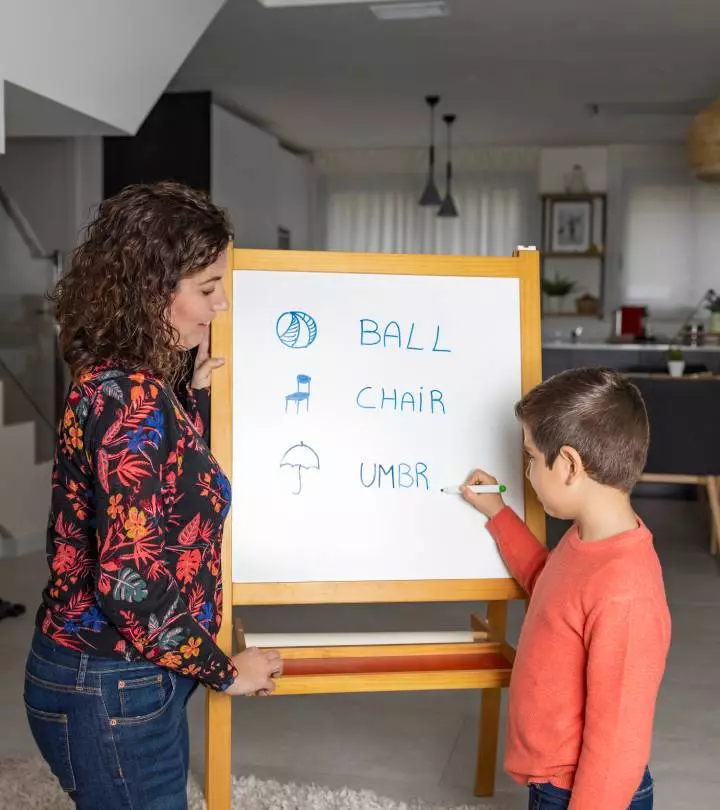
Image: Shutterstock
As a parent, you hold the key to unlocking a world of possibilities for your child, and what better way to broaden their horizons than by introducing them to a second language? The ability to speak more than one language opens doors to new cultures, people, and opportunities. However, navigating this linguistic journey with your little one might seem daunting. Fear not! In this article , we’ll delve into practical and playful tips to make the process of learning a second language a joyous and enriching experience for both you and your child.
From simple daily practices to creating a language-rich environment at home, get ready to embark on an adventure that will not only expand their linguistic skills but also nurture a deep appreciation for diverse cultures. Let’s dive in and uncover the secrets to making language learning a delightful journey for your young explorer. Read on to learn more about this!
1. Start Early, Start Easy
Early birds catch the language worm! Start when they’re young. Kids soak up languages like sponges. Even simple words and songs in another language can get them curious and excited.
2. Make It A Daily Thing
Consistency is key! Make learning a part of your daily routine. Short lessons every day work wonders. Simple activities like reading a story, singing songs, or playing games in the new language can do the trick.
3. Be Their Language Buddy
Image: Shutterstock
You’re their first and best teacher! Join in on the language adventure. Speak, sing, and play together in the new language. Your enthusiasm rubs off on them!
4. Fun And Games
Who said learning can’t be a blast? Use games, puzzles, and apps to make language learning playful. Scavenger hunts, word games, and language-related crafts make it exciting.
5. Real-World Exposure
Bring the language to life! Watch movies, listen to music, or explore cultural events in the new language. Visiting a restaurant or meeting friends who speak the language creates real-world connections.
6. Patience Is Golden
Image: Shutterstock
Rome wasn’t built in a day! Learning takes time, so be patient. Encourage their efforts and celebrate small victories. It’s a journey, not a race.
7. Create A Language Zone
Designate a special spot at home as the “language zone.” Fill it with books, toys, and materials in the new language. It’s their cozy corner for language exploration.
8. Storytime Magic
Books are magical portals! Read stories in the new language. Use colorful picture books and act out the stories. It makes learning engaging and memorable.
9. Celebrate Progress
Image: Shutterstock
Little wins deserve big celebrations! When they speak a new word or phrase, cheer them on. Positive reinforcement keeps them motivated.
10. Mix It Up
Variety is the spice of language learning! Mix different methods like reading, listening, speaking, and writing. It keeps things interesting and helps reinforce learning.
11. Language Exchange
Find language buddies or groups where kids can practice speaking with other kids. Playdates or online sessions with native speakers help boost their confidence.
12. Follow Their Interests
Image: Shutterstock
Fuel their passion! If they love animals, learn animal names in the new language. Tailor language learning around their interests for extra enthusiasm.
13. Travel (If Possible)
If you can, travel to places where the language is spoken. Immersion in the language and culture can be an amazing learning experience.
14. Stay Positive
Keep the vibe upbeat! A positive attitude makes learning enjoyable. Encourage, praise, and make learning a happy experience.
15. Routine Check-Ins
Image: Shutterstock
Regularly check in on their progress. It helps you see what’s working and what might need a tweak. Adjust your approach based on what suits them best.
16. Lead By Example
Monkey see, monkey do! Show them that you’re learning too. Practice speaking the language together, showing them that learning is for everyone.
17. Stay Flexible
Be open to change! Kids learn differently. If one method isn’t clicking, switch gears. Flexibility is key to finding what works best for your child.
18. Stay Encouraging
Image: Shutterstock
You’re their biggest cheerleader! Encouragement and support go a long way. Even on tough days, a little encouragement can lift their spirits.
19. Have Fun Together
Most importantly, have fun! Learning a new language should be exciting, not stressful. Enjoy the journey together!
Teaching your child a second language is an invaluable gift, and with these simple yet impactful tips, you’re not just facilitating language acquisition; you’re nurturing a love for diversity, connections, and endless possibilities. As you infuse daily routines with fun language activities, celebrate small victories, and create a rich environment for exploration, you’re not merely imparting words but fostering a worldview that embraces different cultures. This journey isn’t just about learning; it’s about shared moments of discovery and growth, building bridges between worlds, and nurturing a bond that thrives on curiosity and learning. Embrace this adventure, celebrate every step forward, and witness your child flourish in a world made richer by language, culture, and the joy of learning.


















